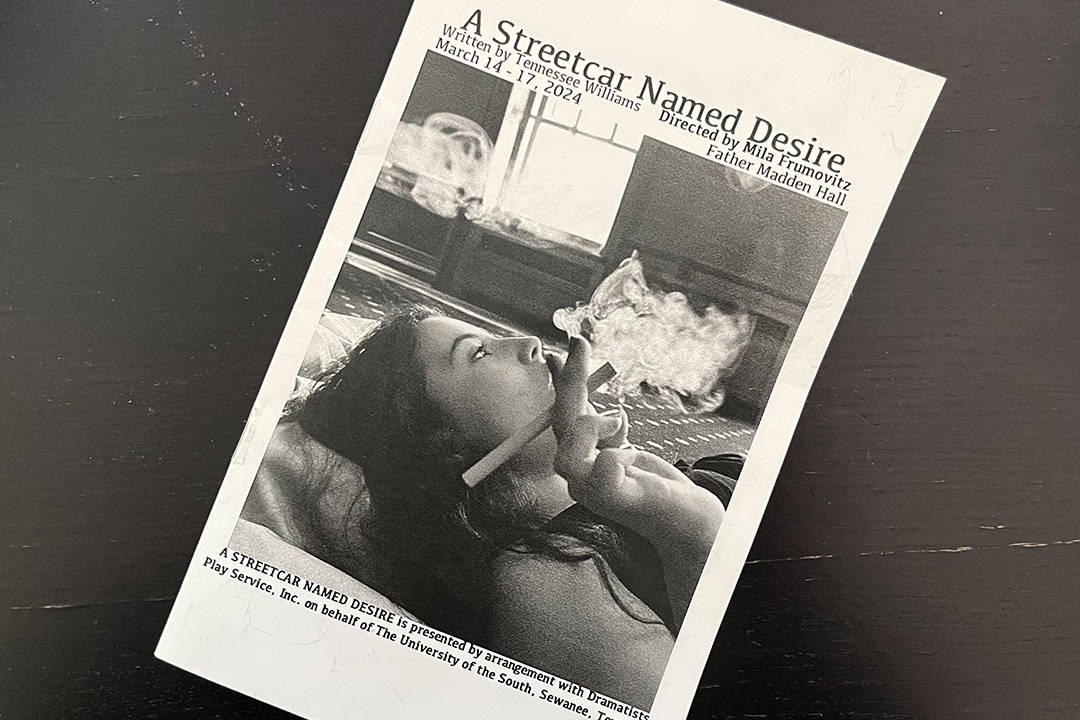When I walked into Father Madden Hall at St. Michael’s College on the evening of March 16, I could hardly believe I was on campus and not at a Queen Street jazz lounge. But this was indeed the Trinity College Dramatic Society’s (TCDS) performance of Tennessee Williams’ moody American classic, A Streetcar Named Desire.
Directed by Mila Frumovitz and running from March 14–17, the play tells the story of a former Southern belle, Blanche DuBois, who escapes tragedy and winds up on her sister Stella’s doorstep. There, she endures the presence of Stella’s aggressive husband, Stanley, whose violent temper and arrogance destabilize Blanche’s delusions of grandeur. The walls of their rickety house echo their toxic arguments until, by the end of the play, somebody has to lose.
Before I even entered the theatre, I knew I was in for a treat. A jazz band serenaded the audience as we took our seats, playing a set so woozy, so sensual, I felt compelled to whip out a cigarette and smoke it off a fire escape, pondering into the night. Charlie Hau on the saxophone literally made me swoon. Sophie Jesdadt on the piano and Dan Prashun on the drums, directed by Lev Tokol, were also great. The band, for the duration of the play and during its interludes, offered a moment of reprieve from the fiery arguments that characterize the iconic play.
The set was equally a stroke of genius: Father Madden Hall, not typically a theatre space, was transformed into a janky but inviting living room. The set design, achieved by Athen Go and their team, was expertly curated down to the last detail, with vintage rugs, bar carts, and old wooden pieces. Clotheslines framed the entire scene, hanging from above. Without a conventional stage, the audience felt immersed in the house — and thus immersed in the messy lives of its residents.
Andrea Perez did an excellent job as the histrionic Blanche DuBois. Blanche’s insecurity was all painfully felt from the jump, as Perez conveyed her lines with the perfect blend of shrill confidence and desperation. The stunning Perez sauntered and twirled across the room in the character’s melodramatic style, and she had my empathy for Blanche fluctuating just as much as Blanche’s emotions themselves.
I didn’t know men at U of T were capable of being Brando-esque, but Nolan Rush proved me wrong. He did an awesome job as Stella’s brutish hunk of a husband, Stanley. His violent fits reverberated throughout the hall, and he mastered his character’s nonchalant airs. I’d give props to his delivery of the iconic line, “STELLAAAAAAA!”
Speaking of Stella: these two hot messes were brought down to earth by Stella herself (Gaby Bondoc) and Mitch (Carl Schienemann). Bondoc’s Stella grounded her sister but still delivered vulnerability and fragility as Stanley’s battered wife, while Schienemann was perfectly earnest as Mitch, a hopeless romantic caught in Blanche and Stanley’s crossfire.
The characters’ constant arguments were anchored by a wonderful use of lighting. Vintage lamps were skillfully coordinated to change colours as Blanche retreated to her steamy bathroom, or as they framed Stella and Stanley locked in embrace. Lighting designer Cass Iacovelli and their team did not miss a beat while creating every scene’s mood.
The music was sensual, the lighting was warm, and the cast was picture-perfect, mingling in their nightgowns among smashed bottles of liquor.
There was only one crucial problem, however: none of them managed to nail their Southern accents. I’ll admit that putting on a Southern drawl for a nearly three-hour, dialogue-heavy play is not a feat I could accomplish. So, while I commend their ambition, unfortunately, a lot of the snappy lines got ‘lost in translation.’
Granted, if the film adaptation is anything to go off of, the mumbled or flustered dialogue is a given in the play. This made the hiccup a bit more excusable, as the audience still managed to glean the plot as it progressed, but I think some of the sexual tension or emotion from certain phrases sadly got muddled, especially in the third act.
The play also would have benefited from softer mic volumes. Seen as it was staged in a hall with soaring ceilings, even the subtler scenes resounded quite loudly. For a play as cacophonous as A Streetcar Named Desire, I wished we, as an audience, had a few moments of quiet relief to make the play’s signature explosive moments truly stand out.
Although the delivery of the play’s dialogue left, well, something to be desired, TCDS’ A Streetcar Named Desire was still a lush, immersive experience. The cast gave committed performances, and when it comes to artful worldbuilding and stage design, it was the most impressive example I’ve seen in U of T theatre yet.



No comments to display.